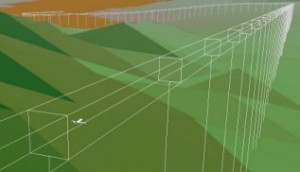The Control and Simulation Division of Delft Aerospace is carrying out the “Airport 2020” and “Flight Deck 2020” projects in close collaboration with partner SIMONA. Both of these projects have been at the basis of the “4-D planning and guidance” or in short “4-D guidance” project. The objective of this project is to find solutions to current and foreseen problems in the air transportation system and to gain insight in the application of revolutionary new approaches to overcome shortcomings in the system. A special focus is on the dimension of time and on better meeting time-based constraints.
The project focuses on necessary improvements related to Air Traffic Control, to the aircraft flight deck and to the interactions between them. Both the Human Factors Laboratory from the Control & Simulation division and the full-motion flight simulator from SIMONA are used as experimental facilities to evaluate the application of the new cockpit interfaces and the new flight procedures studied in this work. On this page the research related to air traffic planning and the work on aircraft instruments are both discussed.
Research on 4-D Air Traffic Planning
With the introduction of Free Flight, air traffic planning has begun to develop in a completely new direction. This way of traffic routing promises significant benefits with respect to flexibility and efficiency, such as time to destination and fuel consumption. However, especially around the major airports it may be necessary to somehow apply a combination of the traditional ATC procedures and the routing method proposed by Free Flight.
Currently, we are studying an operational concept for future arrival and departure management that adopts a much more flexible approach to air navigation by applying on-line optimization techniques. The basic idea is that a central institution like ATC generates flight path constraints which only tell the aircraft at a very high level where to go, allowing the actual route selection and generation to be carried out on-board the aircraft. One way of describing these constraints 3-D is using a tunnel-in-the-sky. While selecting these constraints can already be complex in 3-D, a major issue is the incorporation of the dimension time; this and 4-D theory and analysis in general is part of current work.
In the development of the studied planning methods a major consideration forms the strategy that humans follow in making decisions. Since the traditional way of decision support by providing alternatives does not always seem to be satisfactory new support mechanisms are necessary. The new scheduling algorithms and support mechanisms currently studied are implemented based on the principles of genetic evolution.
Research on 4-D Tunnel-in-the-Sky displays
Perspective flight path displays or tunnel-in-the-sky displays are hot topics in the aviation research community as they are a promising candidate for the future Primary Flight Display (PFD). In this work we are investigating the incorporation of temporal information in a tunnel-in-the-sky display in order to meet a predefined along-track position profile accurately. A first experiment was done in January 2003 in the Human Factors Laboratory where different 4-D visualizations were compared.
Graduation Assignments
Several subjects are of major interest:
- Trajectory Complexity
Using a (relatively unconstrained) intelligent planning method may generate solutions which are too complex and not desirable from a pilots point of view. Therefore, it is necessary to develop a reliable way of describing the complexity of trajectories as experienced by airline pilots. This may very well require experimental measurements in a flight simulator. - Airport Traffic Planning
The main goals of using intelligent automation tools in arrival and departure management is to improve the global situation around major airports in terms of airport throughput, safety, cost efficiency and environmental impact. Consideration of the role of human operators who have to use these tools has to be a major factor in the design. The decision support method currently being implemented is using a genetic algorithm, which tries to improve the quality of the solutions in a set gradually. It is required though to analyze how these solutions evolve exactly and criteria need to be established to determine when a modification qualifies for being passed on to a controller. Also, it is currently not known which benefits can be obtained exactly with these methods and further developments on the automation logic need to be investigated as well. - The Roles of Space and Time in Traffic Planning
While the relationship between space and time is an important research issue in for example theoretical physics, it has not been studied very extensively or fundamentally in traffic planning issues. However, when future traffic planning tools are being developed to schedule traffic in specific volumes of airspace instead of on trajectories it will be essential to first understand better what space-time shapes could be suitable for the process of traffic planning.




